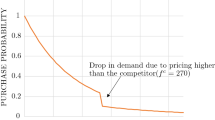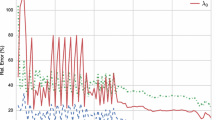Abstract
There is a tendency to focus on the overly simplistic dynamic airline pricing games or to even ignore competition completely, because of the difficulty in solving game theoretic models. Recent changes in the industry mean that airlines can no longer ignore competitors in their model. This article adds more complex customer model aspects – that is, customer choice using a logit model, customer demand using a linear probabilistic demand model and market size using a binary random function – into an existing solvable airline pricing game; originally, this game only used a simple customer model. The newly formed games were solved using a reinforcement learning algorithm with mixed results.





Similar content being viewed by others
References
Bansal, M. and Maglaras, C. (2008) Dynamic pricing when customers strategically time their purchase: Asymptotic optimality of a two-price policy. Journal of Revenue and Pricing Management 8 (1): 42–66.
Bellman, R. (1954) The theory of dynamic programming. Bulletin of American Mathematical Society 60: 503–516.
Bertsimas, D. and de Boer, S. (2005) Simulation-based booking limits for airline revenue management. Operations Research 53 (1): 90–106.
Boyd, E.A. (2007) Perspectives on the future of pricing. Presented at the 7th Annual INFORMS Pricing and Revenue Management Conference; 28–29 June, Barcelona, Spain.
Boyd, E.A. and Kallesen, R. (2004) The science of revenue management when passengers purchase the lowest available fare. Journal of Revenue & Pricing Management 3 (2): 171–177.
Bridle, J.S. (1990) Training stochastic model recognition algorithms as networks can lead to maximum mutual information estimation of parameters. In: D.S. Touretzky (ed.) Advances in Neural Information Processing Systems: Proceedings of the 1989 Conference. San Mateo, CA: Morgan Kaufmann, pp. 211–217.
Brown, G.W. (1951) Iterative solution of game by fictitious play. In: T.C. Koopmans (ed.) Activity Analysis of Production and Allocation. New York: Wiley, pp. 374–376.
Burger, B. and Fuchs, M. (2005) Dynamic pricing – A future airline business model. Journal of Revenue & Pricing Management 4 (1): 39–53.
Chinthalapati, V.L.R., Yadati, N. and Karumanchi, R. (2006) Learning dynamic prices in multiseller electronic retail markets with price sensitive customers, stochastic demands, and inventory replenishments. IEEE Transactions on Systems, Man, and Cybernetics – Part C: Applications and Reviews 36 (1): 92–106.
Collins, A.J. (2009) Evaluating reinforcement learning for game theory application learning to price airline seats under competition. PhD thesis, University of Southampton, UK.
Collins, A.J. and Thomas, L. (2012) Comparing reinforcement learning approaches for solving game theoretic models: A dynamic airline pricing game example. Journal of the Operational Research Society 63 (8): 1165–1173.
Cooper, W.L., Homem-de-Mello, T. and Kleywegt, A.J. (2006) Models of the spiral-down effect in revenue management. Operations Research 54 (5): 968–987.
Currie, C., Cheng, R.C.H. and Smith, H.K. (2008) Dynamic pricing of airline tickets with competition. Journal of the Operational Research Society 59 (8): 1026–1037.
Debreu, G. (1960) Review of individual choice behaviour: A theoretical analysis by R. Duncan Luce. The American Economic Review 50: 186–188.
Donnelly, S., James, A. and Binnion, C. (2004) bmi's response to the changing European airline marketplace. Journal of Revenue & Pricing Management 3 (1): 10–17.
Dunleavy, H. and Phillips, G. (2009) The future of airline revenue management. Journal of Revenue & Pricing Management 8 (4): 388–395.
Fudenberg, D. and Levine, D.K. (1998) The Theory of Learning in Games. London: MIT Press.
Gao, H., Ball, M.O. and Karaesmen, I.Z. (2010) Competitive seat inventory control decisions under the regret criterion. Journal of Revenue and Pricing Management 9 (1–2): 49–65.
Garrow, L.A. and Koppelman, F.S. (2004) Multinomial and nested logit models of airline passengers’ no-show and standby behaviour. Journal of Revenue and Pricing Management 3 (3): 237–253.
Gosavi, A. (2003) Simulation-Based Optimization: Parametric Optimization Techniques and Reinforcement Learning. Norwell, MA: Springer.
Gosavi, A., Bandia, N. and Das, T.K. (2002) A reinforcement learning approach to a single leg airline revenue management problem with multiple fare classes and overbooking. IIE Transactions 34 (9): 729–742.
Gosavi, A., Bandia, N. and Das, T.K. (2007) Simulation optimization for revenue management of airlines with cancellation and overbooking. OR Spectrum 29 (1): 21–38.
Isler, K. and Imhof, H. (2008) A game theoretic model for airline revenue management and competitive pricing. Journal of Revenue and Pricing Management 7 (4): 384–396.
Joe, H. (1997) Multivariate Models and Multivariate Dependence Concepts. Boca Raton, FL: Chapman and Hall/CRC.
Kononen, V. (2006) Dynamic pricing based on asymmetric multiagent reinforcement learning. International Journal of Intelligent Systems 21 (1): 73–98.
Kunnumkal, S. and Topaloglu, H. (2010) A stochastic approximation algorithm for making pricing decisions in network revenue management problems. Journal of Revenue and Pricing Management 9 (5): 419–442.
Luce, R.D. (1959) Individual Choice Behaviour. Oxford: Wiley.
Manski, C.F. (1977) The structure of random utility models. Theory and Decision 8 (3): 229–254.
Maynard Smith, J. (1982) Evolution and the Theory of Games. Cambridge: Cambridge University Press.
McFadden, D. (1980) Econometric models of probabilistic choice among products. Journal of Business 53: S13–S29.
Nash, J. (1951) Non-cooperative games. The Annals of Mathematics 54 (2): 286–295.
Netessine, S. and Shumsky, R.A. (2005) Revenue management games: Horizontal and vertical competition. Management Science 51 (5): 813–831.
Oum, T.H. (1979) A warning on the use of linear logit models in transport mode choice studies. Bell Journal of Economics 10: 374–388.
Pavlov, I.P. (1927) Conditioned Reflexes. Oxford: Oxford University Press.
Pidd, M. (1996) Tools for Thinking: Modelling in Management Science. Chichester, UK: Wiley.
Ratliff, R. and Vinod, B. (2005) Future of revenue management: Airline pricing and revenue management: A future outlook. Journal of Revenue and Pricing Management 4 (3): 302–307.
Rodriguez-Fernández, J.L. (1999) Ockham's razor. Endeavour 23 (3): 121–125.
Rummery, G.A. (1995) Problem solving with reinforcement learning. PhD thesis, Cambridge University, UK.
Salt, J.D. (2008) The seven habits of highly defective simulation projects. Journal of Simulation 2 (3): 155–161.
Shenk, D. (2007) The Immortal Game: A History of Chess. New York: Anchor.
Sridharan, M. and Tesauro, G. (2000) Multi-Agent Q-learning and Regression Trees for Automated Pricing Decisions, In: Proceedings of the 17th International Conference on Machine Learning; 29 June – 2 July, Stanford, CA, pp. 927–934.
Sutton, R.S. and Barto, A. (1998) Reinforcement Learning: An Introduction. Cambridge: MIT Press.
Talluri, K.T. and van Ryzin, G.L. (2004) Theory and Practice of Revenue Management. New York: Springer-Verlag.
Tesauro, G. and Kephart, J.O. (2002) Pricing in agent economies using multi-agent Q-learning. Autonomous Agents and Multi-Agent Systems 5 (3): 289–304.
Thurstone, L.L. (1927a) A law of comparative judgement. Psychological Review 34: 273–286.
Thurstone, L.L. (1927b) Psychological analysis. American Journal of Psychology 38: 368–389.
van Ryzin, G. and Vulcano, G. (2008) Simulation-based optimization of virtual nesting controls for network revenue management. Operations Research 56 (4): 865–880.
Vinod, B., Narayan, C.P. and Ratliff, R.M. (2009) Pricing decision support: Optimising fares in competitive markets. Journal of Revenue and Pricing Management 8 (4): 295–312.
von Neumann, J. and Morgenstern, O. (1944) Theory of Games and Economic Behaviour. Princeton, NJ: Princeton University Press.
von Stackelberg, H.F. (1934) Marktform und Gleichgewicht. Vienna: Julius Springer.
Walczak, D., Mardan, S. and Kallesen, R. (2010) Customer choice, fare adjustments and the marginal expected revenue data transformation: A note on using old yield management techniques in the brave new world of pricing. Journal of Revenue and Pricing Management 9 (1–2): 94–109.
Watkins, C.J.C.H. (1989) Learning from delayed rewards. PhD thesis, Cambridge University, UK.
Author information
Authors and Affiliations
Corresponding author
Additional information
2has been the Professor of Management Science at the University of Southampton since 2000. He was formerly the president of the Operational Research (OR) Society (1994–1995) and was awarded the Beale Medal of OR Society in 2008. Specialist research areas include credit scoring and credit control, and use of management science techniques in financial and banking areas.
Rights and permissions
About this article
Cite this article
Collins, A., Thomas, L. Learning competitive dynamic airline pricing under different customer models. J Revenue Pricing Manag 12, 416–430 (2013). https://doi.org/10.1057/rpm.2013.10
Received:
Revised:
Published:
Issue Date:
DOI: https://doi.org/10.1057/rpm.2013.10




